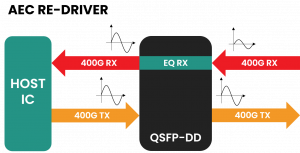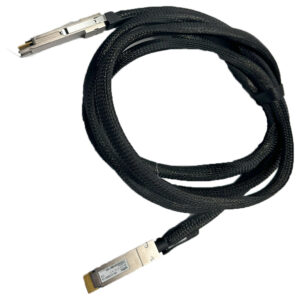Network connectivity speed requirements are increasing as more and more applications (AI, AR/VR, 5G, etc.) are run in cloud. A good balance between speed, power consumption, and face plate density is critical for successful mass adoption of any connectivity technology. With the standardization of 8 lanes of 50G electrical signals in IEEE 400GAUI-8 and the development of a double density QSFP form factor (QSFP-DD), 400G connectivity achieved broad acceptance in the industry. With a maximum of 32 QSFP-DD ports, 400G offers highest density in terms of GB/s/RU and optimized power consumption in terms of Gb/s/W. The 8-parallel lanes-based connectivity also enables 400G to lower speed (50G, 100G) breakout options.
Need for short copper cables for 400G interconnections
400G connections can be realized optically or electrically. Optical solutions are a good choice for inter-rack and long-distance connectivity, anywhere from a few 100s of meters to a few kilometers. Copper cables are an ideal solution for short-distance transmission in data centers because they are less expensive and consume less power than their pure fiber counterparts. Often considered inexpensive and reliable, copper is a good fit for short intra-rack and top-of-rack switch to server connections.
400G copper network cables: DACs, re-driver AECs, and re-timer AECs
400G copper connections use 8-pairs of cables carrying the individual 50G signals. There are two main types of copper cables – direct attach cable (DAC) and active electrical cable (AEC). In a direct attach cable, the electrical signals are carried on the copper cables from point A to point B without any signal conditioning. These are passive in nature and since no signal conditioning is applied, they do not consume any power but are restricted to a short reach of 2-3m.
On the other hand, active electrical cables as the name implies use signal conditioning to improve the quality of the signal, which helps making the cables longer while maintaining the copper conductor’s smaller gauge size. There are two major types of active electric cables based on the signal conditioning applied.
A re-driver-based AEC uses a simpler signal amplification to boost the signal power to extend the reach of the signals and can support a reach of 5-7m with 30 AWG copper cables.


The other option is a re-timer AEC with clock and data recovery (CDR) based signal conditioning which offers the most robust connectivity. A CDR chip, however, consumes more energy and has poor latency compared to the other options.
The pros and cons of each in terms of latency, cost, and handling are laid out in the following table.
| Description | Reach | Cost | Technology | Typical Latency | Power Consumption | Performance |
|---|---|---|---|---|---|---|
| 400G QSFP-DD to QSFP-DD (Passive DAC) | 0.5-2m | $ | N/A; Passive | <10 ps | <0.1W per module | Bend Radius: ~30mm Cable OD: ~7mm Digital Diagnostics: N/A |
| 400G QSFP-DD to QSFP-DD re-driver AEC | 0.5-5m | $$ | Re-driver; Amplification | 600 ps-900 ps (Length Dependent) | 3W per module | Bend Radius: ~30mm Cable OD: ~7mm Digital Diagnostics: Limited |
| 400G QSFP-DD to QSFP-DD CDR AEC | 0.5-9m | $$$ | CDR SOC | ~5 ns | 4.5W per module | Bend Radius: ~30mm Cable OD: ~7mm Digital Diagnostics: Full Monitoring |
Summary
Network designers must carefully weigh the benefits and tradeoffs of each type of cable carefully before making their decision.
Passive DAC provides an excellent option for ultrashort connections where low latency is a priority. If a reach of 5m is required, a re-driver-based AEC offers the most cost-effective solution with the least power consumption. If signal diagnostics are critical for the application and/or a longer reach is required, the CDR based AEC is the best solution.
Vitex is leading the industry with offering 400G copper connections based on all three technologies. Our portfolio consists of straight 400G-400G QSFP-DD and 400G-8x50G and 400G-4x50G breakout configurations. Copper DACs and AECs are the ideal choice for intra-rack server to switch connectivity. Even at 400G and higher data rates, copper connections continue to have a place in the modern-day data center. For product inquiries, reach out to us at info@vitextech.com
Related Products


